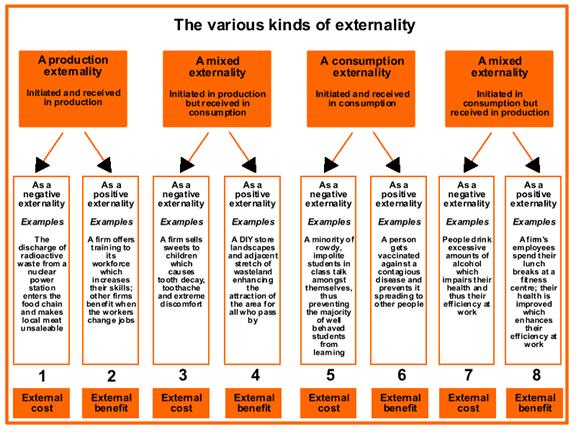Types of externalities
Pollution is an example of an externality which is commonly cited, but it is important to establish at this stage that there are various types of externalities and that they can be classified in different ways: they can arise from acts of consumption or production, and can thus be production, consumption or mixed externalities, and, as previously mentioned they can be experienced as external costs (negative externalities) or as external benefits (positive externalities).
Figure 1 below summarises the different possibilities and provides some examples. It can be seen from this table that there are in fact four different varieties of externality:
A) a production externality: initiated in production and received in production;
B) a mixed externality: initiated in production, but received in consumption;
C) a consumption externality: initiated in consumption and received in consumption;
D) a mixed externality: initiated in consumption, but received in production.
Each of these are sub-divided into two, according to whether they are experienced as an external cost or as an external benefit, giving a total of eight varieties.

Figure 1 The various kinds of externality
In practice, the most important externalities are those which affect the environment, and it is these which have received widespread adverse publicity in recent years, and which have prompted the rise of 'green' pressure groups and political parties. Indeed, so great has been the impact of environmental pollution, that in addition to the externalities identified in figure 1, we can also, in a global context, identify externalities which are transmitted from one country to another, and that may be mutually damaging; for example, the Chernobyl nuclear disaster in 1986 in Russia, not only contaminated the local area, but also polluted other parts of Europe; emissions of acid rain from West European nations not only harm the environment in the initiating countries, but also wreak havoc on the forests, lakes and rivers of the Scandinavian countries. The recent earthquake in Japan and the dangerously high levels of radiation is another example of such externalities.
Task 1
Try adding a further example of your own to each of the eight types of externality given in figure 1.
Task 2
Try matching the following examples of externalities to each type of externality in figure 1 (Hint - there is one example of each). Once you have had a go, have a look at our answer to see how you got on.
- A person smoking a pipe at a football match causes the person sitting behind to passively smoke.
- A large retail organisation attracts numerous extra customers to its store, some of whom spend money in other shops in the vicinity (maybe a shopping mall).
- Children are taken to school by car instead of walking or using public transport. This worsens congestion and raises the production costs of firms.
- Owner occupiers (people who own their own houses/apartments) in a particular area take measures to increase the value of their properties. Estate agents benefits from the extra commission earned when the houses are sold.
- Juggernauts (large trucks/lorries) travel through inner city areas, causing traffic congestion for other commercial road users that raises their production costs.
- A power station emits black fumes into the air that discolours the paintwork of nearby houses.
- Farmers provide pathways in the countryside that benefit walkers.
- A private gardener plants an assortment of beautiful plants in her front garden and enhances the environment for her neighbours and passers-by.
